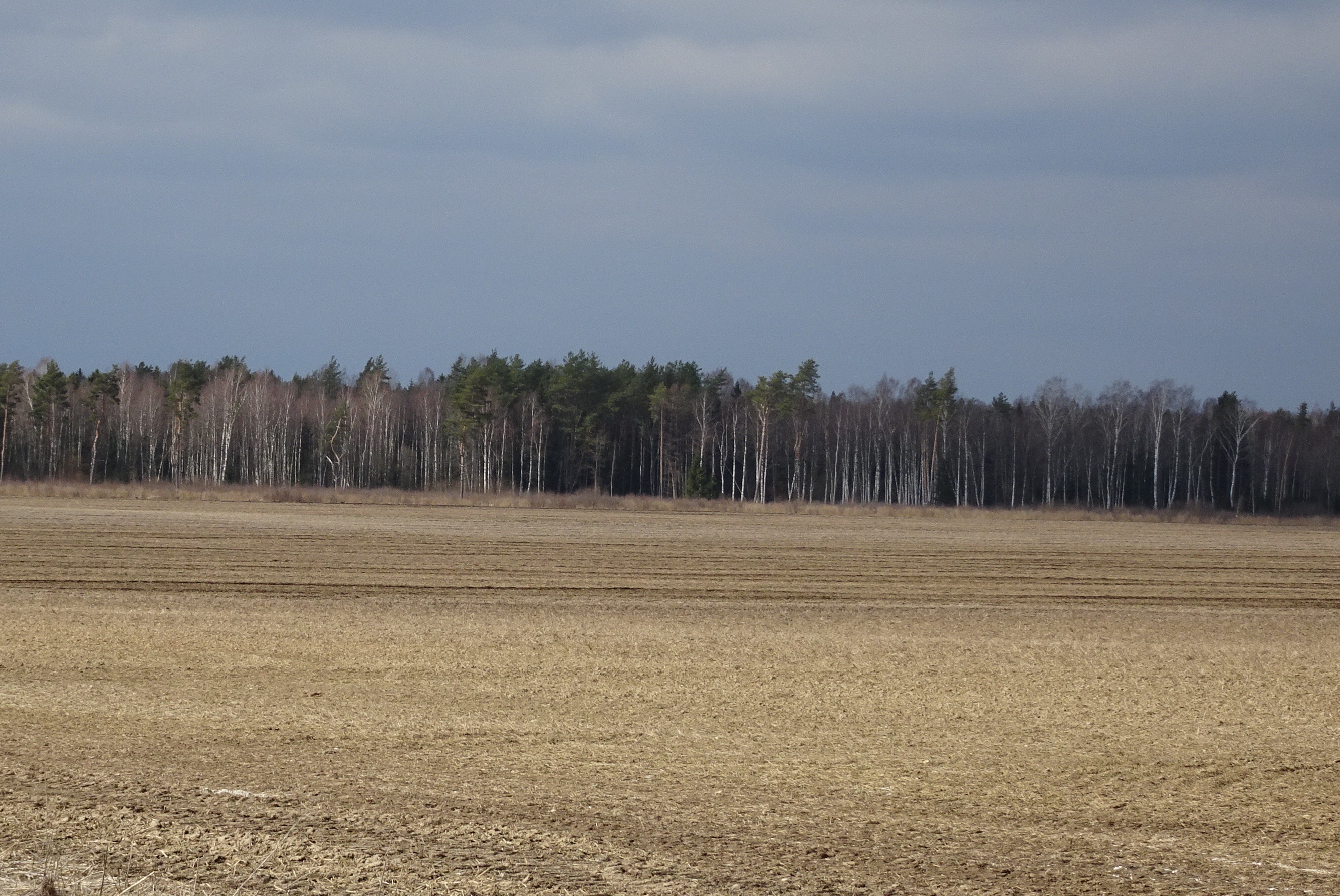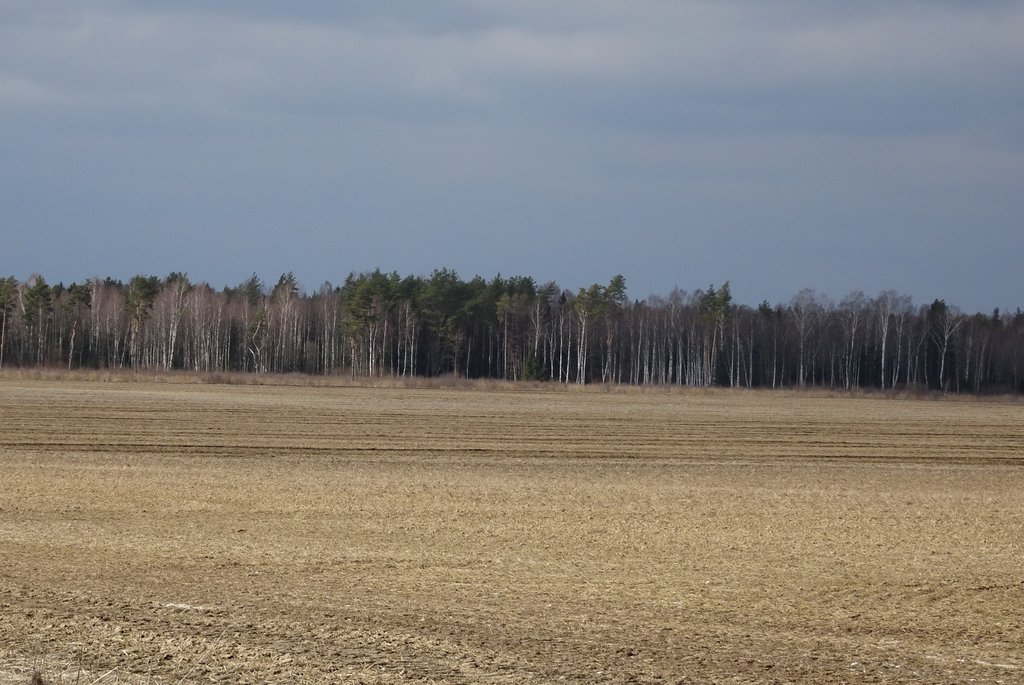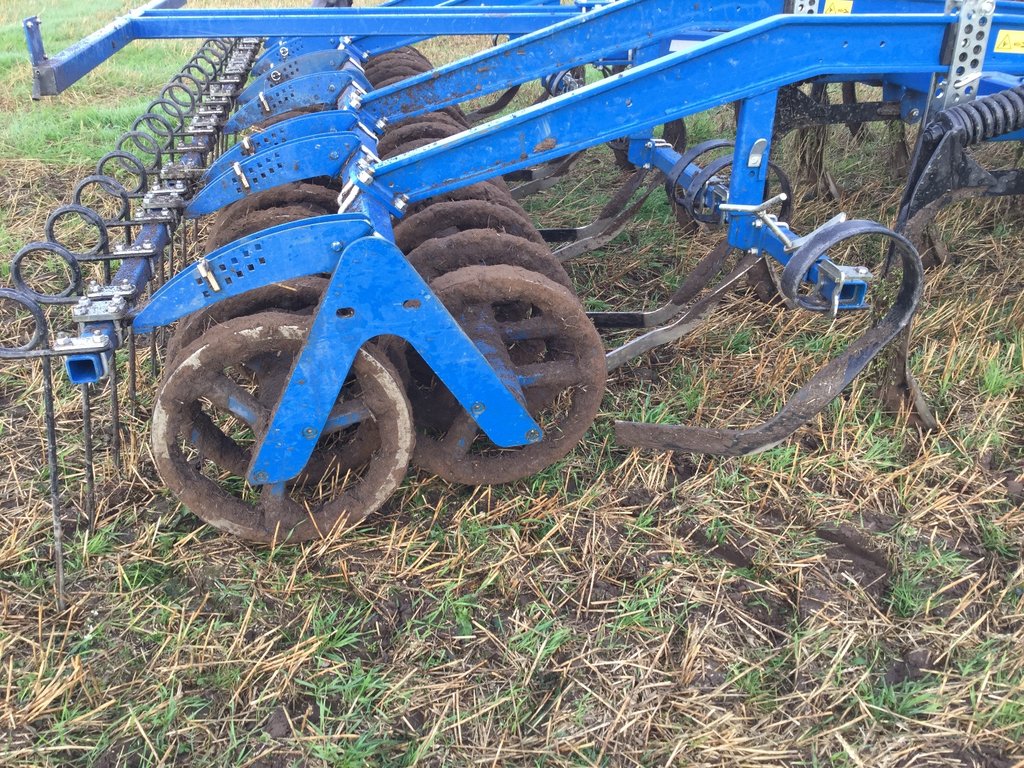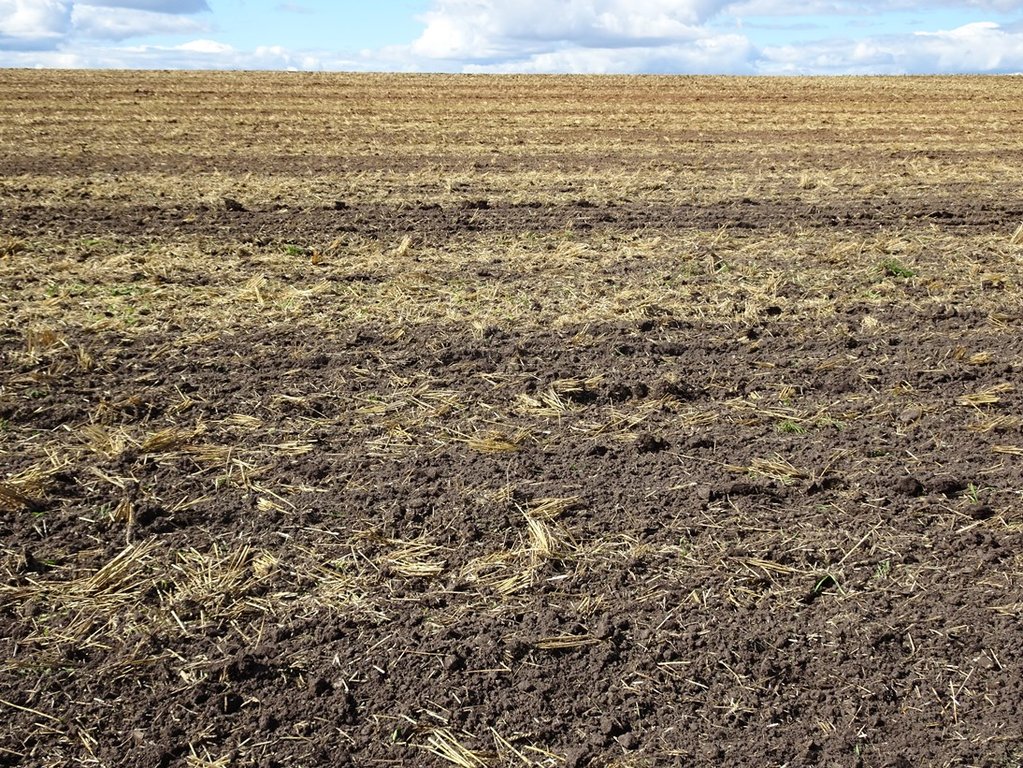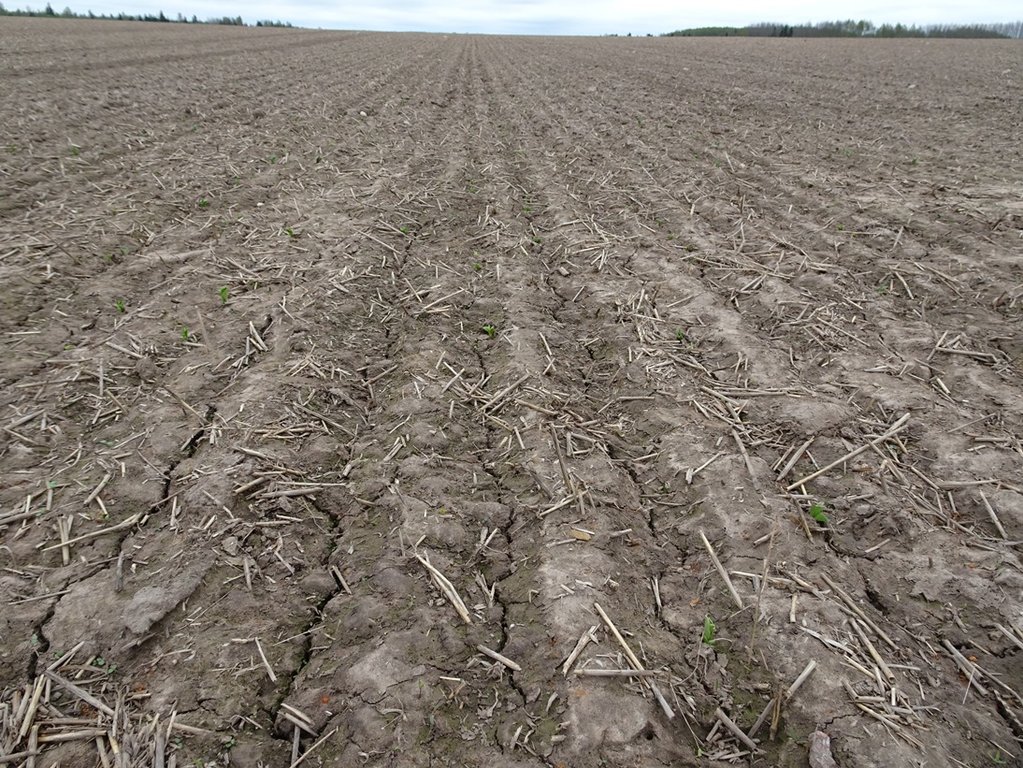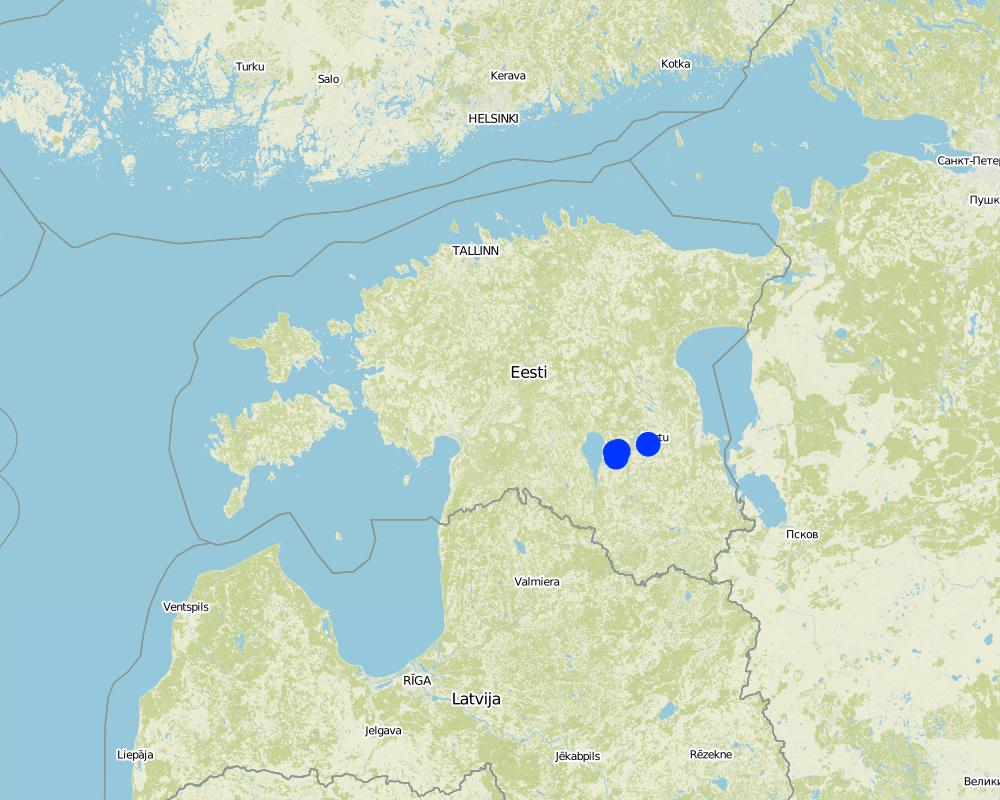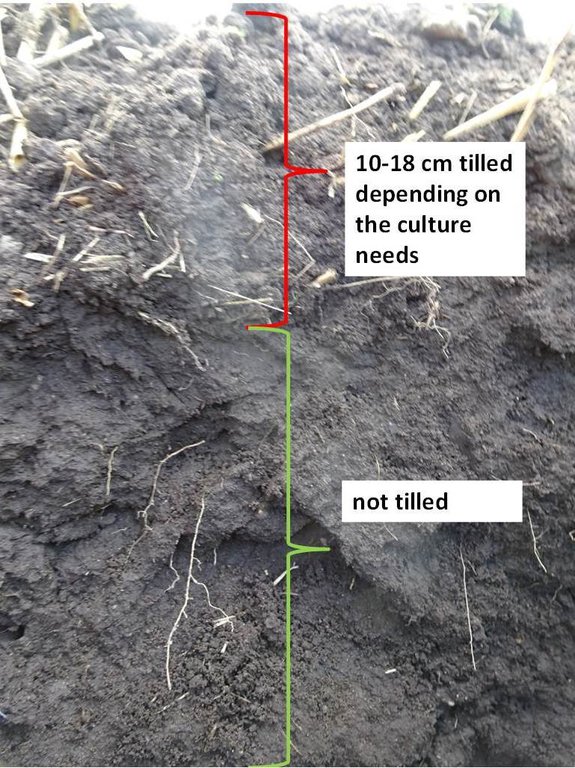Reduced tillage [爱沙尼亚]
- 创建:
- 更新:
- 编制者: Endla Reintam
- 编辑者: –
- 审查者: Ursula Gaemperli, Gudrun Schwilch, Alexandra Gavilano
minimeeritud harimine
technologies_3120 - 爱沙尼亚
查看章节
全部展开 全部收起1. 一般信息
1.2 参与该技术评估和文件编制的资源人员和机构的联系方式
关键资源人
土地使用者:
Aruksaar Ahti
Viljameister OÜ
爱沙尼亚
researcher:
researcher:
Lauringson Enn
Estonian University of Life Sciences
爱沙尼亚
有助于对技术进行记录/评估的项目名称(如相关)
Interactive Soil Quality assessment in Europe and China for Agricultural productivity and Environmental Resilience (EU-iSQAPER)1.3 关于使用通过WOCAT记录的数据的条件
编制者和关键资源人员接受有关使用通过WOCAT记录数据的条件。:
是
1.4 所述技术的可持续性声明
这里所描述的技术在土地退化方面是否存在问题,导致无法被认为是一种可持续的土地管理技术?:
否
2. SLM技术的说明
2.1 技术简介
技术定义:
Reduced (minimum) tillage is a tillage method that does not turn the soil over. Usually only the upper 10-18 cm of the soil surface is tilled.
2.2 技术的详细说明
说明:
The technology is applied in sub-humid climate with an average of 696 mm of precipitations per year, from which more comes from July to October and less in March and April. Average annual temperature is +4 C, length of the growing period is 180-195 days. The territory is mostly flat, the southern part is hilly with slopes of 6-10%. Average altitude from the sea level is 50 m. About half of the Estonian territory is above 50 m and half is below it. Soils are from very shallow (less than 0.1 m) in the north to very deep (> 120m ) in the south. Soil cover is very variable. In the agricultural area the soils are medium textured with low (< 1%) to high (>5%) organic matter in topsoil. Groundwater is near the surface in wet soils and deep in hilly areas. Biodiversity varies from high to low depending on soil and landscape. Market orientation of production system is mixed and off-farm income is less than 10%. Relative level of wealth is average from individual households to cooperatives. Soil management is mechanized. Land belongs to land users, but is leased also in case of bigger farms (over 100 ha).
Reduced tillage is the tillage method used in agriculture to prepare the seedbed. Usually only the upper 10-18 cm of the soil surface is tilled. There is no use of ploughing and thus it is the method that does not turn the soil over. This may involve the use of a chisel plough, field cultivators, or other implements. Depth of the soil preparation depends on the culture in the rotation - before cereals 10-12 cm, before oilseed rape 15-18 cm. The main equipments to prepare the seedbed are the disc cultivator and the tine cultivator or a combined cultivator. The work can be ordered from contractors as well. Usually farms own the equipment.
The main goal is to maintain soil structure, to improve water infiltration, to reduce compaction, and to reduce fuel and labour costs. As there will remain 30% more residues on the soil surface it will promote the activity of soil organisms. Less disturbance in deeper layers increases number of earthworms and increases species diversity. The greatest benefits for the land users are the reduced fuel and labour costs. The reduced tillage is more suitable for crop rotations without root crops. For example, rotation can be as follow: winter oilseed rape - winter wheat - pea (or bean) - winter wheat - spring barley undersown with red clover - red clover. However, the soil compaction and weediness can drastically increase during the first years of the implementation without using a proper crop rotation or management plan. The soil conditions (compaction and weediness) can get worser inside the first 4 years and start to improve after that. It is not suitable for fields which are heavily affected by perennial weeds, as noninversional tillage can spread the weed roots and higher doses of herbicides are needed.
2.3 技术照片
2.5 已应用该技术的、本评估所涵盖的国家/地区/地点
国家:
爱沙尼亚
区域/州/省:
Tartu county
有关地点的进一步说明:
Kobilu
具体说明该技术的分布:
- 均匀地分布在一个区域
如果不知道精确的区域,请注明大致覆盖的区域:
- 1-10 平方千米
注释:
2/3 of cereals is cultivated by minimum tillage technology in Estonia.
Map
×2.6 实施日期
如果不知道确切的年份,请说明大概的日期:
- 不到10年前(最近)
2.7 技术介绍
详细说明该技术是如何引入的:
- 通过土地使用者的创新
3. SLM技术的分类
3.1 该技术的主要目的
- 减少、预防、恢复土地退化
- 创造有益的经济影响
3.2 应用该技术的当前土地利用类型

农田
- 一年一作
年作 - 具体指明作物:
- 谷类 - 大麦
- 谷物类 - 玉米
- 谷类 - 燕麦
- 谷类 - 其他
- 谷类 - 黑麦
- 谷类 - 小麦(春季)
- 谷类 - 小麦(冬季)
- 豆科牧草和豆类 - 豆子
- 豆科牧草和豆类 - 豌豆
- 油料作物 - 向日葵、菜籽、其他
每年的生长季节数:
- 1
具体说明:
One harvest of cereals per year.
注释:
Main crops: winter and spring wheat, winter and spring barley, oat, rye, pea, bean, oilseed rape, corn for silage, buckwheat
3.3 由于技术的实施,土地使用是否发生了变化?
由于技术的实施,土地使用是否发生了变化?:
- 是(请在技术实施前填写以下有关土地利用的问题)

农田
- 一年一作
注释:
Before the use of reduced tillage conventional tillage (with ploughing) has been used.
3.4 供水
该技术所应用土地的供水:
- 雨养
3.5 该技术所属的SLM组
- 改良的地面/植被覆盖
- 最小的土壤扰动
3.6 包含该技术的可持续土地管理措施

农艺措施
- A3:土壤表面处理
3.7 该技术强调的主要土地退化类型

土壤水蚀
- Wt:表土流失/地表侵蚀

土壤风蚀
- Et:表土流失

化学性土壤退化
- Cn:肥力下降和有机质含量下降(非侵蚀所致)

物理性土壤退化
- Pc:压实
3.8 防止、减少或恢复土地退化
具体数量名该技术与土地退化有关的目标:
- 防止土地退化
- 减少土地退化
4. 技术规范、实施活动、投入和成本
4.1 该技术的技术图纸
技术规范(与技术图纸相关):
To till the soil chisel ploughing or disc cultivator is used without turning the soil over. For cereals the suitable depth is 10-12 cm, for oilseed rape 15-18 cm. Ca 30% from straw will remain on the soil surface. To loosen the soil of deeper layers the deep chiseling down to 25 cm is used.
作者:
Endla Reintam
日期:
14/08/2017
4.2 有关投入和成本计算的一般信息
具体说明成本和投入是如何计算的:
- 每个技术单元
指定单位:
hectar
其它/国家货币(具体说明):
EUR
如相关,注明美元与当地货币的汇率(例如1美元=79.9巴西雷亚尔):1美元=:
1.18
注明雇用劳工的每日平均工资成本:
36-40 EUR/day + taxes
4.3 技术建立活动
| 活动 | 时间(季度) | |
|---|---|---|
| 1. | Purchase of cultivator (disc or combination cultivator) |
4.4 技术建立所需要的费用和投入
| 对投入进行具体说明 | 单位 | 数量 | 单位成本 | 每项投入的总成本 | 土地使用者承担的成本% | |
|---|---|---|---|---|---|---|
| 设备 | Disc cultivator | piece | 1.0 | 15000.0 | 15000.0 | 100.0 |
| 技术建立所需总成本 | 15000.0 | |||||
| 技术建立总成本,美元 | 12711.86 | |||||
4.5 维护/经常性活动
| 活动 | 时间/频率 | |
|---|---|---|
| 1. | Seedbed preparation (tillage before drilling) | before drilling (spring crops in spring (April), winter crops in autumn (August)) |
| 2. | Fertilization, drilling | in spring or in autumn, drilling and fertlization at the same time |
| 3. | Plant protection | up to 3 times during growth period depending of weediness, infections and insects |
| 4. | Fertilization during growth period | For winter crops in spring after snowmelt in the beginning of growth, for spring crops in the beginning of intensive growth |
| 5. | Harvest and grain transport | in the end of season (end of July to beginning of September depending of the crop) |
| 6. | Drying of grain and soil tillage | after harvest |
注释:
The example is based on the assumption that the yield will be around 6 t/ha and we grow cereals (winter or spring wheat)
4.6 维护/经常性活动所需要的费用和投入(每年)
| 对投入进行具体说明 | 单位 | 数量 | 单位成本 | 每项投入的总成本 | 土地使用者承担的成本% | |
|---|---|---|---|---|---|---|
| 设备 | Seedbed preparation, fertilization, sowing | times | 1.0 | 131.9 | 131.9 | 100.0 |
| 设备 | Plant protection | times | 3.0 | 11.2 | 33.6 | 100.0 |
| 设备 | Fertilization during growth period | times | 1.0 | 16.2 | 16.2 | 100.0 |
| 设备 | Harvest and grain transport | times | 1.0 | 118.5 | 118.5 | 100.0 |
| 设备 | Drying and after harvest activities | times | 1.0 | 132.1 | 132.1 | 100.0 |
| 植物材料 | seeds | kg | 200.0 | 0.28 | 56.0 | 100.0 |
| 肥料和杀菌剂 | Ammonium nitrate (2x per season) 147 kg/ha N (200 kg fertilizer per ha) | kg | 147.0 | 0.84 | 123.48 | 100.0 |
| 肥料和杀菌剂 | Complex fertilizer (27 kg N, 40 kg P and 112 kg K per ha) (450 kg of fertilizer per ha) | kg | 179.0 | 0.74 | 132.46 | 100.0 |
| 肥料和杀菌剂 | Herbicides (1 time) | times | 1.0 | 27.0 | 27.0 | 100.0 |
| 肥料和杀菌剂 | Fungicides (1 time) | times | 1.0 | 33.2 | 33.2 | 100.0 |
| 肥料和杀菌剂 | Insecticides (1 time) | times | 1.0 | 3.6 | 3.6 | 100.0 |
| 肥料和杀菌剂 | Retartants | times | 1.0 | 14.0 | 14.0 | 100.0 |
| 技术维护所需总成本 | 822.04 | |||||
| 技术维护总成本,美元 | 696.64 | |||||
如果土地使用者负担的费用少于100%,请注明由谁负担其余费用:
Agricultural producers can have governmental support per unit 83.71 EUR/ha and the greening support 38.81 EUR/ha.
注释:
The labour costs are included to the machinery work costs. An average the labour cost for a driver is 15-18 EUR/ha. The average machinery work costs to produce 4.5 t of winter wheat were 388 EUR/ha, 355 EUR/ha and 322 EUR/ha in conventional, minimum and no-tillage, respectively in 2016. Cost of production in this case was 159 EUR/t, 152 EUR/t and 147 EUR/t in conventional, minimum and no-tillage, respectively.
To produce the same amount of spring barley, the cost of machinery was 365 EUR/ha, 345 EUR/ha and 300 EUR/ha in conventional, minimum and no-tillage, respectively. Cost of production in this case was 142 EUR/t, 139 EUR/t and 129 EUR/t in conventional, minimum and no-tillage, respectively.
The machinery cost for minimum tillage is 33 EUR and 20 EUR less than for conventional plough based tillage for winter wheat and spring barley, respectively.
By minimum tillage the use of fuel is ca 38% less than by ploughing.
4.7 影响成本的最重要因素
描述影响成本的最决定性因素:
Fuel costs, labour cost
5. 自然和人文环境
5.1 气候
年降雨量
- < 250毫米
- 251-500毫米
- 501-750毫米
- 751-1,000毫米
- 1,001-1,500毫米
- 1,501-2,000毫米
- 2,001-3,000毫米
- 3,001-4,000毫米
- > 4,000毫米
指定年平均降雨量(若已知),单位为mm:
696.00
有关降雨的规范/注释:
Average 696 mm, almost equally spread over the year, more from July to October, less in March and April.
注明所考虑的参考气象站名称:
Tartu Tõravere
农业气候带
- 半湿润
LGP 180-195 days
5.2 地形
平均坡度:
- 水平(0-2%)
- 缓降(3-5%)
- 平缓(6-10%)
- 滚坡(11-15%)
- 崎岖(16-30%)
- 陡峭(31-60%)
- 非常陡峭(>60%)
地形:
- 高原/平原
- 山脊
- 山坡
- 山地斜坡
- 麓坡
- 谷底
垂直分布带:
- 0-100 m a.s.l.
- 101-500 m a.s.l.
- 501-1,000 m a.s.l.
- 1,001-1,500 m a.s.l.
- 1,501-2,000 m a.s.l.
- 2,001-2,500 m a.s.l.
- 2,501-3,000 m a.s.l.
- 3,001-4,000 m a.s.l.
- > 4,000 m a.s.l.
说明该技术是否专门应用于:
- 凸形情况
5.3 土壤
平均土层深度:
- 非常浅(0-20厘米)
- 浅(21-50厘米)
- 中等深度(51-80厘米)
- 深(81-120厘米)
- 非常深(> 120厘米)
土壤质地(表土):
- 中粒(壤土、粉土)
土壤质地(地表以下> 20厘米):
- 中粒(壤土、粉土)
表土有机质:
- 中(1-3%)
如有可能,附上完整的土壤描述或具体说明可用的信息,例如土壤类型、土壤酸碱度、阳离子交换能力、氮、盐度等。:
On the main investigated area it is sandy loan Stagnic Luvisol, in some parts Calcaric Luvisol. pH in water 6.9-7.3
5.4 水资源可用性和质量
地下水位表:
5-50米
地表水的可用性:
好
水质(未处理):
良好饮用水
水的盐度有问题吗?:
否
该区域正在发生洪水吗?:
否
5.5 生物多样性
物种多样性:
- 中等
栖息地多样性:
- 中等
5.6 应用该技术的土地使用者的特征
定栖或游牧:
- 定栖的
生产系统的市场定位:
- 商业/市场
非农收入:
- 低于全部收入的10%
相对财富水平:
- 平均水平
个人或集体:
- 个人/家庭
- 合作社
机械化水平:
- 机械化/电动
性别:
- 女人
- 男人
土地使用者的年龄:
- 青年人
- 中年人
5.7 应用该技术的土地使用者使用的平均土地面积
- < 0.5 公顷
- 0.5-1 公顷
- 1-2 公顷
- 2-5公顷
- 5-15公顷
- 15-50公顷
- 50-100公顷
- 100-500公顷
- 500-1,000公顷
- 1,000-10,000公顷
- > 10,000公顷
这被认为是小规模、中规模还是大规模的(参照当地实际情况)?:
- 中等规模的
注释:
The total area of one investigated farm is 1036 ha (all covered by minimum tillage), another farm size is 2320 ha and under minimum tillage it is 1231.5 ha.
5.8 土地所有权、土地使用权和水使用权
土地所有权:
- 州
- 公司
土地使用权:
- 租赁
- 个人
用水权:
- 自由进入(无组织)
- 个人
5.9 进入服务和基础设施的通道
健康:
- 贫瘠
- 适度的
- 好
教育:
- 贫瘠
- 适度的
- 好
技术援助:
- 贫瘠
- 适度的
- 好
就业(例如非农):
- 贫瘠
- 适度的
- 好
市场:
- 贫瘠
- 适度的
- 好
能源:
- 贫瘠
- 适度的
- 好
道路和交通:
- 贫瘠
- 适度的
- 好
饮用水和卫生设施:
- 贫瘠
- 适度的
- 好
金融服务:
- 贫瘠
- 适度的
- 好
6. 影响和结论性说明
6.1 该技术的现场影响
社会经济效应
生产
作物生产
SLM之前的数量:
6.3
SLM之后的数量:
6.75
注释/具体说明:
The example is based on winter wheat. For spring barley 4.56 and 4.52, for spring oilseed rape 2.24 and 2.15 t/ha with ploughing and with minimum tillage, respectively.
Different studies have shown that the yield can be higher and also lower compared to the conventional tillage. It depends also on the weather conditions and intensity of mangement (fertilization, pesticides).
作物质量
SLM之前的数量:
37.7
SLM之后的数量:
38.1
注释/具体说明:
The weight of thousand grain of winter wheat can be higher under minimum tillage than under conventional tillage in some years. As an average of different years, there is no differences and under conventional tillage the weight of 1000 grains can be slightly higher.
土地管理
注释/具体说明:
As there is no conventional ploughing, the management is simplified. However, bigger attention should be paid on weed management and crop rotation, which may hinders the land management. There is need to include weed suppressing species, such red clover (or similar) into the rotation.
收入和成本
农业投入费用
SLM之前的数量:
10.1
SLM之后的数量:
5.2
注释/具体说明:
Fuel cost by ploughing and with minimum tillage as EUR/ha. The fuel demand for tillage will decrease from ca 14 l/ha to 7.2 l/ha
农业收入
注释/具体说明:
Production costs for producing 1 ton of winter wheat are 5 EUR less by minimum tillage than by ploughing at high yield level (6 t/ha). In some calculations they show 1.7-1.8 times less costs for tillage by minimum tillage compared to ploughing.
工作量
注释/具体说明:
Field operations takes less time, decreasing labour costs.
社会文化影响
食品安全/自给自足
注释/具体说明:
Decreasing production costs allows to sell the food with lower price.
SLM/土地退化知识
注释/具体说明:
Farmers turning to the minimum tillage have to clarify for themselves the behaviour of their soils, crop rotations etc. to prevent excess compaction, weed infestation.
生态影响
水循环/径流
水的回收/收集
注释/具体说明:
30% remaining residues on the soil surface helps to catch more snow during the winter.
地表径流
注释/具体说明:
Higher amount of residues on the soil surface allows water to infiltrate quicker into the soil, as raindrops can not damaging the soil structure as much as after ploughing.
多余水的排放
注释/具体说明:
Better soil structure allows water to infiltrate quicker into the soil. Without ploughpan and with intact pore system water drains quicker to the deeper soil.
蒸发
注释/具体说明:
30% plant residues do not allow water to evaporate in the same speed as by ploughing.
土壤
土壤水分
注释/具体说明:
Slight differences in deeper soil (20-25 cm) ca. 4% more moisture in minimum than conventional tillage.
土壤覆盖层
SLM之前的数量:
0
SLM之后的数量:
30%
注释/具体说明:
30% more plant residues remain on the soil surface after minimum tillage compared to the ploughing.
土壤流失
注释/具体说明:
Extra residues on the soil surface and better soil structure compared to ploughing reduces soil loss by wind and water.
土壤堆积
注释/具体说明:
Increase of soil organic carbon by 0.1-0.2% compared to ploughing.
土壤结壳/密封
注释/具体说明:
Stronger soil structure because the increasing organic carbon level improves the resistance to raindrop impact and by this it reduces soil crusting.
土壤压实
注释/具体说明:
In the layer 10-20 cm the increase can be over 0.2 g/cm3 compared to ploughed soils. However, after 4-5 years the conditions starts to improve and there will be less compaction in mentioned layer and deeper (plough pan starts to disappear).
养分循环/补给
注释/具体说明:
Less intensive decomposition of organic matter leaves more nutrients in the soil.
土壤有机物/地下C
注释/具体说明:
Slight increase of organic carbon by 0.1-0.2%. Depends more on crop rotation than tillage method.
生物多样性:植被、动物
植被覆盖
注释/具体说明:
Due to the need to suppress weeds more winter crops or cover crops are included into the rotation. However, this effect can only be stated if the rotation and management plan will be changed.
植物多样性
注释/具体说明:
Due to the need of changes in crop rotation, more diverse rotations instead of monoculture to suppress weeds. Weeds diversity might increase due to the reduced tillage intensity.
动物多样性
注释/具体说明:
More spiders, beetles, ants compared to ploughed soils.
有益物种
SLM之前的数量:
2 species of earthworms
SLM之后的数量:
3-4 species of earthworms
注释/具体说明:
More earthworm species and higher abundance compared to ploughed soils.
害虫/疾病控制
注释/具体说明:
Due to the decreased tillage intensity more attention should be paid on weed, pests and disease control by crop rotation and pesticies. As the residues remain on the soil surface there are also better conditions for pests and disease spreading.
减少气候和灾害风险
碳和温室气体的排放
注释/具体说明:
Due to the decreased decomposition intensity, less CO2 emission from soil organic matter (increase of soil organic matter 0.1-0.2% compared to ploughing). As the fuel consumption is ca 40% less than by ploughing, less emission is coming from agriculture.
火灾风险
注释/具体说明:
As there will remain 30% of residues on the soil surface, there is an increased risk of fires in spring.
微气候
注释/具体说明:
Residues regulate soil evapotranspiration and temperature. The fluctuations are not so high as by ploughing.
6.2 该技术的场外影响已经显现
缓冲/过滤能力
注释/具体说明:
As the soil organic carbon content increases, also the water holding and the nutrient holding capacity increase.
风力搬运沉积物
注释/具体说明:
Less sediments due to the lower tillge intensity and more residues on the soil surface
对邻近农田的破坏
注释/具体说明:
Less sediments from the field to the neighbours fields. Effect on water erosion depends on the slope.
对公共/私人基础设施的破坏
注释/具体说明:
Due to the reduced water erosion, less soil will be transported to the diches and roads (depends on slope).
温室气体的影响
注释/具体说明:
Due to the decreased decomposition intensity, less CO2 emission from soil organic matter (increase of soil organic matter 0.1-0.2% compared to ploughing). As the fuel consumption is ca 40% less than by ploughing, less emission comes from agriculture.
6.3 技术对渐变气候以及与气候相关的极端情况/灾害的暴露和敏感性(土地使用者认为的极端情况/灾害)
渐变气候
渐变气候
| 季节 | 增加或减少 | 该技术是如何应对的? | |
|---|---|---|---|
| 年温度 | 增加 | 未知 | |
| 季节性温度 | 冬季 | 增加 | 未知 |
| 季节性温度 | 春季 | 增加 | 未知 |
| 年降雨量 | 增加 | 未知 | |
| 季雨量 | 冬季 | 增加 | 未知 |
| 季雨量 | 秋季 | 增加 | 未知 |
气候有关的极端情况(灾害)
气象灾害
| 该技术是如何应对的? | |
|---|---|
| 局地暴雨 | 未知 |
| 局地雷暴 | 未知 |
| 局地雹灾 | 未知 |
| 局地雪暴 | 未知 |
| 局地风暴 | 未知 |
气候灾害
| 该技术是如何应对的? | |
|---|---|
| 寒潮 | 未知 |
| 极端冬季条件 | 未知 |
| 陆地火灾 | 适度 |
6.4 成本效益分析
技术收益与技术建立成本相比如何(从土地使用者的角度看)?
短期回报:
轻度消极
长期回报:
积极
技术收益与技术维护成本/经常性成本相比如何(从土地使用者的角度看)?
短期回报:
积极
长期回报:
积极
6.5 技术采用
- 1-10%
如若可行,进行量化(住户数量和/或覆盖面积):
85 371 ha
在所有采用这项技术的人当中,有多少人是自发的,即未获得任何物质奖励/付款?:
- 91-100%
6.6 适应
最近是否对该技术进行了修改以适应不断变化的条件?:
否
6.7 该技术的优点/长处/机会
| 土地使用者眼中的长处/优势/机会 |
|---|
| Decrease of work load, time and labour costs. |
| Decrease of fuel consumption, increase of income. |
| Increase of soil biological activity, soil organic matter content, better structure and infiltration. |
| 编制者或其他关键资源人员认为的长处/优势/机会 |
|---|
| Decrease of soil organic carbon decomposition. |
| Decrease of soil erosion. |
| Increase of soil biological activity. |
6.8 技术的弱点/缺点/风险及其克服方法
| 土地使用者认为的弱点/缺点/风险 | 如何克服它们? |
|---|---|
| Increase of weed abundance and soil compaction | Proper crop rotation and timing |
| 编制者或其他关键资源人员认为的弱点/缺点/风险 | 如何克服它们? |
|---|---|
| Higher use of pesticides and risk to soil and water pollution. | Changes in crop rotation, use of cover crops |
7. 参考和链接
7.1 信息的方法/来源
- 实地考察、实地调查
5 during the iSQAPER project, more than 20 in total with other projects
- 与土地使用者的访谈
5, more than 40 in total with other projects
- 根据报告和其他现有文档进行编译
7
(现场)数据是什么时候汇编的?:
18/05/2017
7.2 参考可用出版物
标题、作者、年份、ISBN:
Minimeeritud harimine ja otsekülv. 2017. P. Viil. Eesti Taimekasvatuse Instituut. ISBN 978-9949-9742-2-1:
可以从哪里获得?成本如何?
ISBN 978-9949-9742-2-1
7.3 链接到网络上的相关信息
标题/说明:
Kattetulu arvestused taime- ja loomakasvatuses 2016. Koost: Marju Aamisepp, Helle Persitski. Maamajanduse infokeskus. 2017.:
URL:
http://www.maainfo.ee/data/trykis/kattetulu/KATTETULU2016.pdf
标题/说明:
Statistics Estonia
URL:
https://www.stat.ee/en
标题/说明:
Erinevate viljelusmeetodite ( sh. otsekülv) rakendusteaduslik kompleksuuring. Riikliku programmi “Põllumajanduslikud rakendusuuringud ja
URL:
http://www.pikk.ee/upload/les/Erinevad_viljelusviisid_pikk_aruanne.pdf
标题/说明:
Minimeeritud harimine ja otsekülv. 2017. P. Viil. Eesti Taimekasvatuse Instituut.:
URL:
http://taim.etki.ee/taim/public/pdf/Trukised/Otseklv-minimeeritudmullaharimine.
标题/说明:
Eesti maaelu arengukava 2014-2020 4. ja 5. prioriteedi meetmete ja 3. prioriteedi loomade heaolu meetme püsihindamisaruanne 2015. aasta kohta ja
URL:
http://pmk.agri.ee/mak/avaleht/
标题/说明:
Projekti ”Erinevate mullaharimise ja külvitehnoloogiate mõ-ju uuring tera- ja kaunviljade saagikusele viljavahelduslikus ja monokultuurses külvikorras” lõpparuanne
URL:
http://www.pikk.ee/upload/files/Teadusinfo/Lopparuanne_111_2002_2006.pdf
标题/说明:
Eesti tuleviku kliimastsenaariumid aastani 2100
URL:
https://www.envir.ee/sites/default/files/kliimastsenaariumid_kaur_aruanne_ver190815.pdf
链接和模块
全部展开 全部收起链接
无链接
模块
无模块


